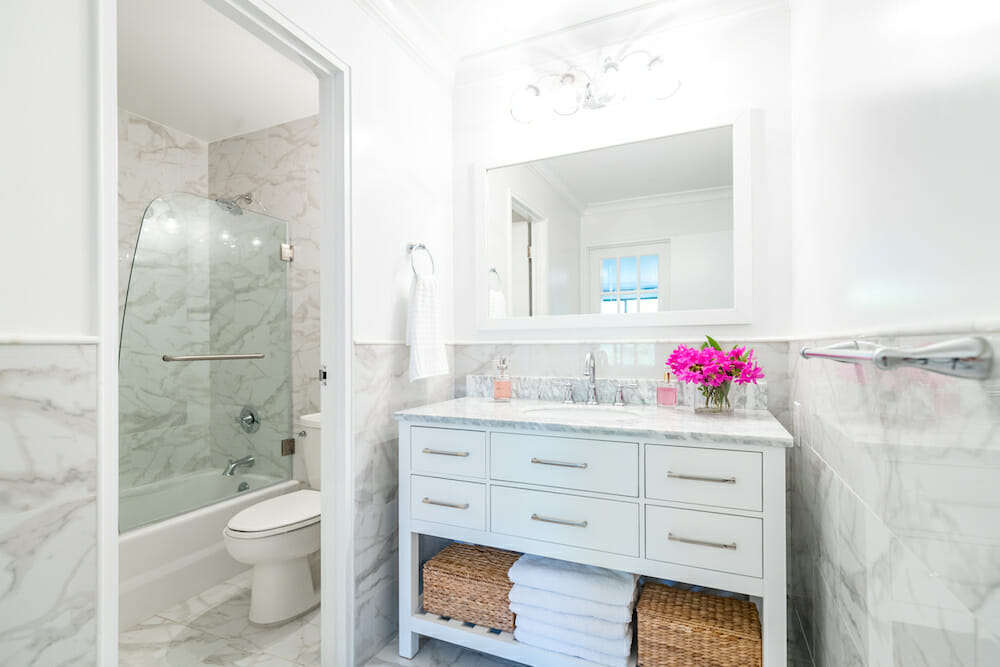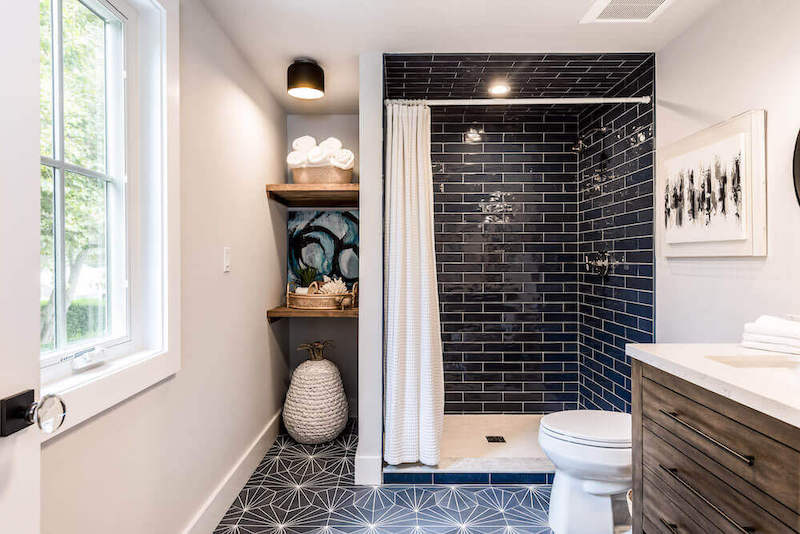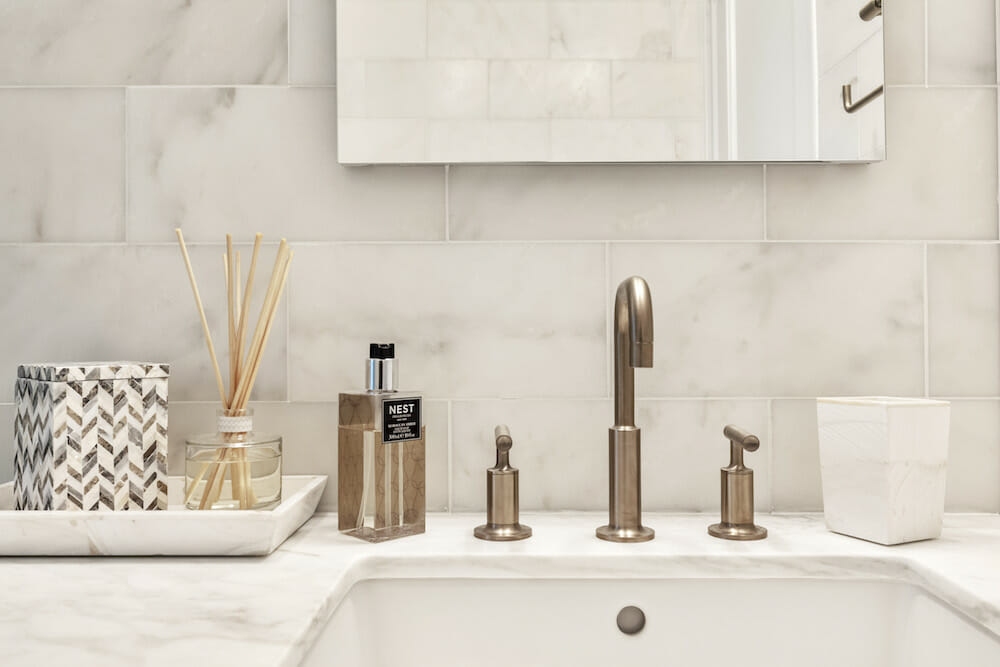The Difference Between Carrara and Calacatta Marble
In the Carrara vs Calacatta debate, understanding their cost, maintenance, design, and best applications is key
(Above) Sweeten homeowner Dan’s kitchen with Calacatta marble
The names are similar, and the products are even quarried from the same region. Yet Carrara and Calacatta marble are so different, that you won’t ever mistake the two once you see them side-by-side. Carrara and Calacatta marble are highly valued as building products in bathrooms, kitchens, and in other areas of the home. To help clarify the distinction between these two Italian marbles, Sweeten lays out the pros and cons of Carrara vs. Calacatta, and why you might choose one over the other.
Sweeten matches home renovation projects with vetted general contractors, offering guidance, tools, and support—for free.
Carrara vs Calacatta Marble: What are they?
Carrara marble
Carrara marble is an off-white or blue-gray softly veined marble from the Apuan Alps in northwest Italy, near Carrara. Historically, Carrara marble can be seen in statues and in large public and commercial buildings. However, Carrara marble is now more commonplace in residential homes.
The core, or field, of Carrara marble is light-gray, with vague bluish tones. The streaks, called veins, are light-gray, too. The veins are slightly darker than the field.
The veins found in Carrara marble are subtle, not pronounced. Instead, they are soft, watery, or feathery. Carrara marble veins seem to continue and dissipate into the field.
(Above) Sweeten homeowners Tina and Andrew’s kitchen with Carrara marble
Calacatta marble
Calacatta marble is a type of Carrara marble. It comes from the same overall region of Tuscany, Italy.
Calacatta marble tends to have a white field. Usually, the whiter the field, the more expensive the marble.
The feature that distinguishes Calacatta marble is its veining. Calacatta’s veins are thick, bold, defined, and often colorful. Calacatta marble’s veins range from dark-gray and beige up to darker browns and even gold.
Calacatta has few veins, but those veins stand out in sharp contrast to the white field.
Should you choose Carrara or Calacatta marble?
Carrara marble
Homeowners who desire the overall look of marble, but want a more understated look, should choose Carrara marble.
Renovate to live, Sweeten to thrive!
Sweeten brings homeowners an exceptional renovation experience by personally matching trusted general contractors to your project, while offering expert guidance and support—at no cost to you.
Carrara marble does an excellent job of blending into the room as a whole rather than calling attention to itself. Because Carrara takes more of a backseat, it can be used across large expanses for walls and flooring.
Calacatta marble
Calacatta marble is for homeowners who want to show off this unique, gorgeous stone. It’s a marble that truly looks the way marble should look.
Because Calacatta marble is all about its veins, it is well-suited to bookmatching. Bookmatching pairs two marble slabs from the same cut so that adjacent slabs mirror each other. This gives the appearance of an open book.
Calacatta marble’s distinctive veins make bookmatching possible. With Carrara marble, you can bookmatch slabs, but the effect may not be evident.
Calacatta vs Carrara Cost: Which is more expensive?
Nobody can call marble a “bargain” building material. However, Carrara marble is far less expensive than Calacatta marble; around half the price.
(Above) Sweeten homeowner Tatiana’s bath with Calacatta marble
Pros and cons of marble
Pros
- Premium building material
- High resale value
- Unique, every slab is different
- Natural building material
- Lasts long with proper maintenance
Cons
- Expensive
- Soft, chips easily
- Heavy
- Stains
- Requires maintenance
Why is marble popular?
All building materials have their trends. But marble’s popularity remains more stable than other materials. In fact, no other material looks quite like it.
For some homes, marble isn’t just the best choice, it’s the only choice. Marble is frequently the go-to pick for high-end houses with a classic or traditional style. It doesn’t hurt that marble’s history is rich and deep, as marble is associated with Roman buildings and classic sculptures.
Functionally, marble is dense, heavy, and permanent. It resists heat well. It’s also more commonly found than one might think. Italy produces Carrara and Calacatta marble, but Spain, India, China, Turkey, Greece, and the U.S. also produce other types of marble.
(Above) Sweeten homeowner Kristen’s bath with Calacatta marble
Best uses of marble in the home:
- Kitchen counters: Use marble as your main kitchen countertop material.
- Kitchen island counters: Pair the main kitchen counters with a slab of marble on the kitchen island. Or use marble alone here.
- Kitchen or bathroom backsplashes: Marble works well for backsplashes in the kitchen (though not behind the stove) or behind the bathroom sink.
- Entry or foyer hallways: Marble has long been used in foyers, lobbies, and other entry rooms as a show-stopper to welcome visitors.
- Bathtub or shower surrounds: Marble is waterproof when sealed, making it a perfect fit for shower or bathtub wall surrounds.
- Bathroom floor tile: Marble is a hardy floor covering for bathrooms, plus it stands up well to water.
- Fireplace surrounds: Polished marble can be used for fireplace surrounds as it can be wiped clean.
How to clean marble and maintain it
You should always seal marble used around the home. Keep the stone regularly sealed. When drops of water no longer bead up on the surface, it’s time to seal the stone again.
Acidic liquids can etch marble. Avoid having vinegar, citrus, or tomatoes sit on the marble for very long. Clean them up quickly. Use cutting boards.
Clean marble with gentle methods. Vacuum or sweep up crumbs or dirt. Every so often, use a damp mop or cloth. Look for a good cleaner designed just for marble. Never use abrasive powders or abrasive materials on the marble.
—
Sweeten handpicks the best general contractors to match each project’s location, budget, scope, and style. Follow the blog, Sweeten Stories, for renovation ideas and inspiration and when you’re ready to renovate, start your renovation with Sweeten.
Carrara marble is a veined marble from the Apuan Alps in northwest Italy, near Carrara. Carrara marble was historically used for statues and public and commercial buildings, but in modern times, it is used in residential houses. Carrara marble is off-white or blue-gray in color, with streaks (or “veins”) of light gray which are slightly darker than the core color. The veins in Carrara are subtle, as opposed to the bold, deep veins found in Calacatta marble.
Always clean marble with gentle methods–never use abrasive powders or abrasive materials on marble as the surface is soft and chips easily. Vacuum or sweep up crumbs or dirt. Every so often, use a damp mop or cloth using a cleaner designed just for marble.
Yes, Carrara marble needs to be sealed. Test whether you need to re-seal your marble by dropping beads of water onto its surface. If the water does not bead up on the surface, it’s time to seal the stone again.
Carrara marble can be used as a bathroom vanity topper, as it stands up well to water, but needs to be maintained carefully. Since marble is a soft stone that etches and chips easily, avoid using abrasive materials or acidic liquids while cleaning its surface.













